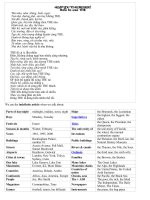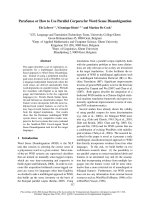How to use the english for teaching better
Bạn đang xem bản rút gọn của tài liệu. Xem và tải ngay bản đầy đủ của tài liệu tại đây (98.79 KB, 19 trang )
THANH HOA DEPARTMENT OF EDUCATION AND TRAINING
THIEU HOA EDUCATION AND TRAINING DIVISION
EXPERIENCED INITIATIVE
“HOW TO USE THE ENGLISH FOR TEACHING BETTER”
The writer: Tong Thi Xuan
Position: Teacher
Work unit : Thieu Hoa secondary school
Experienced initiative: English
THANH HOA - 2018
INDEX
CONTENTS
1. Introduction
1.1. Reason for choosing the topic
1.2. Researched purposes
1.3. Researched subjects
1.4. Researched Methods
1.5. New points of the experienced initiative
2. Content of the experienced initiative
2.1. Theoretical basis of the experienced initiative
2.1.1. Definitions of English For Teaching (EFT)
PAGES
Page 1
Page 1
Page 1
Page 1
Page 2
Page 2
Page 3
Page 3
Page 3
2.1.2. An overview on English for Teaching (EFT)
Page 3
2.1.3. Factors to be considered of EFT application
Page 3
2.2. The problem state before the application of the experienced
initiative
Page 4
2.2.1. Classroom Management
Page 4
2.2.2. Media content
Page 10
2.2.3. Giving Feedback
Page 12
2.3. The solutions used to solve the problems
Page 13
2.4. The effectiveness of the experienced initiative for educational Page 14
activities, with my self, colleagues and the school
Page 15
3. Connect and Suggest
3.1. Conclusion
Page 15
3.2. Recommendations
Page 16
1. Introduction
1.1. Reason for choosing the topic
As we know, English has increasingly developed and played an important role
in our economy and society. Most of the students in Viet Nam have not only aimed
at passing their exams and getting some further studies for their future life, but also
they have had a desire to be integrated into the culture, the civilization, and the
people of English speaking countries. Many students are not confident to speak
and express their English in class whereas most of the English lessons are carried
out in traditional methods. That is, the teacher presents new grammar verbally, and
then students do, turn by turn, exercises in workbooks. As a consequence, the
students find it hard to speak out as well as to communicate in the real life
naturally.
1.2. Researched purposes
Most of us know that English is now a global professional language for
teachers. They use English both to teach and to communicate about their work.
However, in fact, we have had some surveys when visiting some English classes of
secondary schools in Thieu Hoa district – Thanh Hoa province; we find that some
teachers are using Vietnamese to teach English. They say that they are not
confident enough to teach English in English, and they often think that if they use
100% English in class, their students will not understand what they say, what they
want. It was not until September, 2017 when we were invited to take part in the
course that we realised sometimes we also use quite a lot of native when teaching
English in the classrooms. Nevertheless, after the course, we all felt much more
confident when using English in the classrooms. We learned a lot from the course,
we have had some useful experiences from the trainers and teachers. We think that,
our responsibility is to retrain what we learned from the course to other teachers in
our province.
For all the reasons above, I think it is very necessary for all of us to teach
English in English. It is not only good for you but also good for your study. Our
thesis will help you with this.
1.3. Researched subjects
To encourage teachers to teach English in English, not using native.
To help teachers with the specific classroom language they need to teach
confidently in English.
To investigate the difficulties of using “Classroom Language” of secondary
school teachers in their teaching English.
To make some suggestions on reducing the teachers’ difficulties in the
application of EFT and make English lessons in Thieu Hoa Secondary School
more interesting and successful.
1.4. Researched Methods
1.4.1. What are the difficulties faced by the students of Thieu Hoa Secondary
School in learning English and their expectations?
1
1.4.2. What are the difficulties faced by the teachers of Thieu Hoa Secondary
School in using English for teaching and their own solutions?
1.5. New points of the experienced initiative
The study is concerned with finding the teachers’difficulties in using English
For Teaching for students from grade 6 to grade 9 at Thieu Hoa Secondary
School. The study of others would be beyond the scope.
2. Content of the experienced initiative
2.1. Theoretical basis of the experienced initiative
2.1.1. Definitions of English For Teaching (EFT)
English For Teaching (EFT) provides teachers with the specific classroom
language they need to teach confidently in English. Teachers learn and practice the
English needed to.
Manage their classroom.
Prepare and teach their instructional materials.
Provide learners with feedback.
2.1.2. An overview on English for Teaching (EFT)
In this project, we will introduce different phrases that can be put to
immediate use in language classroom, on topics including classroom management,
communicating lesson content and giving feedback to students. Word List of many
words and phrases used in the classroom. Animated Lean activities that illustrate
the target language in a classroom context. Practice activities that gives teachers
feedback on their pronunciation. Opportunities for reflection after each part.
2.1.3. Factors to be considered of EFT application
Teachers’ belief and attitudes.
Teachers’ qualities and personalities.
Learners’ motivation.
Learners’ beliefs and attitudes.
Learners’ learning style.
Learners’ anxiety and confidence.
Classroom conditions.
Language environment.
Syllabuses and textbooks.
2.2. The problem state before the application of the experienced initiative
As far as we know. Being teachers of English, we always think about how to
make our lessons more and more attractive and effective. And the most importance
is that after the lesson, our students not only can use English to communicate with
their friends but they also can use their English to communicate with foreigners
fluently and naturally. But this is also our biggest problem and it is very difficult
for us to find solution. Luckily, while we were wandering how to face this
problem, we were taken part in the course for teachers of English from well2
qualified schools. The course helped us find solution to this problem, and today we
are sharing you some experiences that we learned form the course. These are
different phrases that you can use in your classroom. They are very simple, but
sometimes we don’t remember or sometimes we don’t know how to use and when
to use them properly and effectively.
Let us introduce some specific examples to you. We hope that the phrases will
help you a lot with your teaching career.
Before introducing the phrases, please look at our survey of students’ using
English in classroom before carrying out the research.
SURVEY
Class Number Not good
of
at using
students classroom
language
6A
6B
8A
35
33
33
16
17
15
%
48.6
51,5
45,5
Quite
good at
using
classroom
language
14
12
13
%
Good at
using
classroom
language
%
39.3
36,4
39,3
5
4
5
12.1
12,1
15,2
2.2.1. Classroom Management
* Greeting students
Hi, everyone. [3]
Hello. [3]
Good morning boys and girls
Good afternoon class/ students/ children
How are you? [3]
How are you doing?
How is everyone today? [3]
Good to see you.
Fine, thanks. [3]
Great, thanks.
Fine, thank you. And you?
How was your vacation? / break / weekend/ summer?
* Discussing the date and the weather
The date
What day is today? Today is...... [3]
What day is tomorrow? [3]
What day was yesterday? [3]
3
What’s month? - It’s..............
The Weather
What season is it? [3]
What’s the weather like? [3]
How’s the weather?
* Taking the attendance
Where is Ana?
Is there everyone here?
Who’s absent today? [ 3]
I’m going to take attendance now.
Raise your hand when I call your name.
Please say “here” / “present” when I call your name.
* Reviewing and collecting students work
- Review
Let’s check your homework. [ 3]
Let’s go over your homework together.
Ana, please read the first sentence.
What’s your answer to question 1?
Please exchange papers with your partner.
- Collecting
Please take out your homework.
Please hand in your papers. [ 3]
Please put your homework on my desk.
Please bring your homework next time.
Please pass your papers to me. [ 3]
* Making announcement
- Getting students’ attention
I have something to tell you.
I have an announcement to make / tell you.
I have some important information for you.
Please, listen carefully.
Please, write it down / them down.
Please copy from the board.
I have some announcement to make.
- Announcing - Test and quizzes
We’ll have a test tomorrow. [ 3]
There will be a test on June 7.
4
Remember that we have a test tomorrow.
The test is on Unit 6.
Don’t forget to study for the test.
Remember to study chapter 7 for the test.
The test has 10 questions.
The test will take 20 minutes. [ 3]
Don’t forget about the test on Tuesday.
I have an announcement to make / some announcements.
- Announcing projects and special assignments
We are going to do a protect on family.
We will do a project on clothing.
The project is due on May 30.
You should finish the report by June 1st.
Work on your own.
There’s a new due date for the project.
Making announcement
There’s a change in the schedule.
We’re going to finish class early tomorrow.
We’ll have a visitor today.
Tomorrow there’s no class because it’s holiday. [ 3]
There will be a parent meeting on Monday.
Don’t forget about the concert tonight.
Give this notice to your parents.
We’re coming back at 2 pm.
Announcing schedule changes and events
There will not be recess today.
We will not have a break today.
Recess will be shorter today.
We’re going to read first today.
Tomorrow, there’s no class because it’s a holiday. [ 3]
Announcing extra curricular activities
There will be a parent meeting on .........
We’re going to have a visitor on ............
Don’t forget about the concert tonight.
Tell your parents about the parent meeting tomorrow.
Give this note to your parents.
On September 15, we will go to the zoo.
5
We’re coming back at 2 pm.
* Using class materials
Do you have a pencil?
Please take out you books. [ 3]
Open your book. [ 3]
Please turn to the page 27. [ 3]
Put away your notebook.
Turn out your page.
Write your name on your paper.
Hand in your paper.
The exercise is at the top of page 28.
* Teaching classroom language
Repeat after me please. [ 3]
You can say “Can you repeat that please?” [ 3]
“May I go to the bathroom, please?”
When you don’t understand
Please ask me in English.
Repeat, ask “What does this mean?” [ 3]
Get ready for lunch.
You can say, “Can you repeat that, please?” [ 3]
You can say, “Can you speak more slowly?” [ 3]
You can say, “Can you write it on the board?”
You can say, “May I go to the bathroom, please?”
* Giving test and give instructions
Now you are going to have a quiz on family words.
Put away your books. [ 3]
Clear your desk.
Please be quiet.
I’m going to read the instruction aloud.
Pay attention to the instructions. [ 3]
Write the name on the test.
Do your own work.
No talking.
Please finish up.
Put your pencil down.
You have five more minutes to finish the test.
Don’t forget to check your work again.
6
Remember to read the instructions carefully.
Time is up.
Stop writing.
* Changing activities
- Getting students’ attention
Please listen. [ 3]
Attention please. [ 3]
Can you pay attention please? [ 3]
Let’s get started.
-. Making a new activity
Let’s get started.
Turn to page 31. [ 3]
Ok, everyone. Let’s start an exercise in Unit 5.
Let’s look at the picture on page 37.
Now, let’s move on to the next activity.
We will now start a different activity.
Now, we will learn something new.
* Disciplining
Please listen. [ 3]
Be quiet. [ 3]
Stop talking.
One at a time.
Please pay attention. [ 3]
Sit down please. [ 3]
Please take turns. [ 3]
Once at a time.
Please get to work.
Please raise your hand.
Please look at your own paper.
* Checking student understanding
Is that clear? [ 3]
Is everything clear?
Please read the instruction.
I’ll read the instruction.
Do you understand the instruction?[1]
Are there any questions? [1]
Do you have any questions?
7
Let me give you an example. [ 3]
Are the examples clear?
Do you want another example?
Let’s review the instruction.
Are there any questions? [1]
If you have a question, please raise your hand. [ 3]
Let me explain the chart again.
…So what are you going to do?
What are you going to talk about?
* Encouraging participants
Please raise you hand.[1]
Please speak louder. [ 3]
Please read aloud. [ 3]
Who want to volunteer?
Who knows the answer? [1]
Do you want to try number 2?
* Motivating students
Good job. [1]
Don’t give up. You are doing great.
Keep trying.
You can do it. [ 3]
Just do you best?
You can say that in English. [ 3]
Don’t worry, take your time.
Try that in English. You can do it.
Don’t worry. I’ll explain it again.
* Assigning homework
Your homework is due next class.
Review the vocabulary for a quiz.
Practice the conversation on page 35.
Write sentences using vocabulary.
For our next class, please listen to the dialogue on page 20.
You homework is to read the text, then answer the questions.
Next time, don’t forget to bring your homework.
* Dismissing the class
Good bye. [ 3]
See you tomorrow.
8
Class is finished. [ 3]
You can go now.
Have a good afternoon.
Good job today.
It’s time to clean up.
Please clean up your area.
Please put away your books. [ 3]
2.2.2. Media content
* Understanding and communicating lesson goals
- Reviewing from the previous class
Let’s review yesterday’s lesson.
What did you do yesterday? [ 3]
Who can tell me what we talked about yesterday.
Who remember what we talked about last class?
Are there any questions? [1]
- Sequencing lesson goals
Today, we are going to continue our unit. [ 3]
Today, we will continue learning words for room in a house.
In this unit we are going to study words about the house.
In this unit we are going to work on talking about houses.
First, we are going to review the vocabulary.
Then we are going to practice the past tense.
Finally we will write sentences.
- Summarizing the Day’s lesson
What did we learn today? [1]
I want to go over what we learned today.
Let’s review what we learn today?
Today we talked about words for room.
Let’s look at that vocabulary again.
* Explaining lessons content to students in English
- Explaining lesson content
This is…….
They are………..
- Modeling and giving examples
Please repeat after me[ 3]
Please read the sentences.
Please listen to the example.[2]
9
Here’s an example. [ 3]
Here’s an example of a preposition.
Let me give you an example of a preposition.
Look at the example on the board.
Jack, please read the example.
Let’s watch John and Jack.
- Asking for and writing students examples
Give me an example of part of your morning routine.
Give me another example of occupation.
Can you think of an example of a fruit?
Who can give an example of an adjective?
Who can give another example of an animal?
- Giving activity instructions
Look at the pictures. [1], [ 3]
Work with a partner. [ 3]
Give information.
Play a game in pairs.
Think about your family.
Guess the words.
Take turn to read the paragraph.
Draw your ideas.
Circle the correct word.
Find a student.
Check your paper with the partner.
Choose the title for the article.[3]
Match the questions and answers.[3]
Practice saying the description.
Use your notes to write a paragraph.
- Organizing students
Please work by yourself.
Find a partner.[3]
Work with a partner.[3]
Pair up.
You can work together.[2]
You have to get into group of three.
Work in groups of three.[3]
Count off by twos.
10
Sara, please work with Paul.[2]
Sara and Paul, work together please.
Sit in a circle.
Face the board.
Take turn reading the dialog.
You have 5 more minutes.
You have until 9 o’clock to finish this activity.
Paul, you are A, Sara, you are B.
This half of the class is A and this half is B.
2.2.3. Giving Feedback
* Giving positive feedback
Good! [ 3]
Very good! [ 3]
Great. [ 3]
Good job.
Excellent. [ 3]
Nice work.
Well done!
Ok. [ 3]
All right.
That’s right.
Right.
* Encouraging self- correction A
That isn’t correct. [ 3]
That is incorrect. [1]
Who has a different idea? [1]
That’s not right.[1], [ 3]
This word is wrong.[1], [ 3]
Something is missing.
Add another word.
Use another verb.
Don’t add another word.
There’s an extra word here.
What does this mean? [ 3]
Do you mean “likes” or “liked”?
I think you are trying to say “liked” not “likes”.
Remember we are talking about the past.
11
There is a problem with this sentence.
This sentence is incomplete.
Don’t forget to follow the word order in the example.
* Encouraging self- correction B
What’s missing?
There was a word missing.
What’s wrong with this sentence?
Does this verb look right?
Try adding another word.
Try using another tense.
Please, look at this sentence again.
Look at the difference between “like” and “likes”.
This sentence is off topic.
Pay attention to the verbs.
Remember the irregular form.
Compare your work to the example.
Check spelling. [ 3]
2.3. The solutions used to solve the problems
Difficulties encountered by teachers at Thieu Hoa High School when using
classroom language in teaching and our own solutions
Deficiency in strategic and sociolinguistic competence in English.
Students’ low English proficiency.
Students’ passive learning style.
Large class size.
The grammar-based exams
Lack of authentic teaching materials.
Students’ not participating in class activities.
Students’ lack of motivation to communicate.
Students’ use of Vietnamese.
Other difficulties.
To overcome the difficulties, the teachers give a variety of suggestions such as
attending workshops or seminars on CLT, being trained and retrained on
sociolinguistic competence, motivating students more to learn English. What is
more, having self- improvement in their English level and teaching methods,
giving encouragements and positive correction and feedback on their students’
mistakes, and using the language which is suitable with the students’ level in the
classroom.
12
2.4. The effectiveness of the experienced initiative for educational activities,
with my self, colleagues and the school
Firstly, it is essential to improve students’ motivation in learning grammar.
Using simple language.
Giving interesting topics, games and communicative activities such as
information gaps, role - plays, interviews, pictures and picture stories, puzzles and
problems and matching activities.
Organizing English speaking club.
Group work is a good suggestion.
Furthermore, the teachers should encourage students’ participation in class
activities.
Students’ role and teachers’ role should be redefined too.
It is evident that teachers should improve their authentic teaching materials
initiatively and creatively.
What is more, grammar should be presented in context in order to make clear
the relationship between grammatical forms and communication functions.
Mistake correction should be positive and effective.
Collecting mistakes made by the student and involving the whole class as
much as possible in the correction process.
Spending less time correcting what is only problem for one student and more
time on problems common to the whole group.
Encouraging students to use English regularly and use it at anytime or
anywhere if possible.
Not interrupting the student before he/ she finishes his/her utterances because
he will find it disconcerting or frustrating.
Trying not to repeat the mistakes, even in mocking and astonishing way. Last
but not least, the teachers should use classroom language in their teaching as much
as possible.
The result of the research (survey of students’ using English in classroom
after 8 months carrying out the research)
After using positive teaching methods, I obtained the following results:
SURVEY
Class Number Not good %
Quite good %
Good at
%
of
at using
at using
using
students classroom
classroom
classroom
language
language
language
6A
35
7
20
18
51,4
10
28,6
6B
33
8
24,2
16
48,5
9
27,3
8A
33
7
21.2
16
48,5
10
30,3
13
3. Connect and Suggest
3.1. Conclusion
In conclusion, through the research we have found out what are the teachers’
difficulties in using English For Teaching (EFT) communicatively. The study also
reveals variety of phrases that teachers can use in their classrooms; the
recommendations for overcoming these difficulties as well as having effective
English lessons in Thieu Hoa Secondary School – Thieu Hoa District – Thanh Hoa
Province. Obviously, when applying EFT in classroom, there is no ready-made
recipe for which techniques and activities can work best for which structure, but
the primary principle is the use of a variety of techniques and activities to suit
different students’ levels and learning styles. This not only helps teachers and
students use classroom language more effectively but also change the students’
learning styles and motivation. The implementation of EFT at Thieu Hoa
Secondary School will be successful if there is contribution and cooperation
of the administrators, teachers and students. Among these factors, the teachers
are central and affect the success or failure of the innovation.
Nonetheless, the limitations of the research are unavoidable. Firstly, from the
scope of the study, the results of the study are only more suitable for higher
students, not for all students at Thieu Hoa Secondary School. Moreover, the data
were only taken from self-reported questionnaires and teachers’ interviews.
However, there is a potential limitation of self-report data because some students
might not be willing to express themselves frankly.
Basing on the results and the limitations of the research, we would like to
make some recommendations for further study. The subjects of the study were
three higher classes (6A, 6B, 8A). As a consequence, the results cannot apply
for all students at Thieu Hoa Secondary School. Furthermore, it is necessary to
conduct other study on the difficulties confronted by teachers in terms of EFT
application in teaching reading, listening, vocabulary, speaking and writing.
I would like to get your frank and useful comments to make my research
better.
Thank you so much!
3.2. Recommendations
To derive from the basis of reasoning, practice, teaching purposes as well as
successes and shortcomings while implementing the topic, to contribute to teaching
English in general , I have the following practical suggestions:
* On the base
As a foreign language environment, skills should be practiced in the manner
of teaching methods, so it is necessary to have a department to avoid noise in
adjacent classes as well as without being affected by noise from outside. (Can be
combined with other departments)
The electric system needs to be repaired to ensure its usefulness and safety
when used.
14
Especially , the school should have a private listening room.
* To the upper management:
It is necessary to create opportunities for teachers to exchange experiences
and learn experiences through seminars.
Encourage teachers to improve their learning and self-learning, and improve
their level of self-sufficiency to meet the growing social needs.
Principal’s confirmation
Thieu Hoa, April 22nd, 2018
I assure this is my experience
initiative, not copying the contents of
other people.
The writer
Tong Thi Xuan
15
REFERENCES
1. Author: Donald Freeman and Laura Le Dréan. Title “Developing Classroom
English Competence: Learning from the Vietnam Experience ” - by IDP Education
(Cambodia) Ltd. Published 2017.
2. Author: Jack C. Richards - Willy.A – Renandya. Title: Methodology in language
teaching - by Cambride University Press- published 2002.
3. The training materials for “ English For Teaching ” of Thanh Hoa Department of
Education and Training – 2017
16
17









